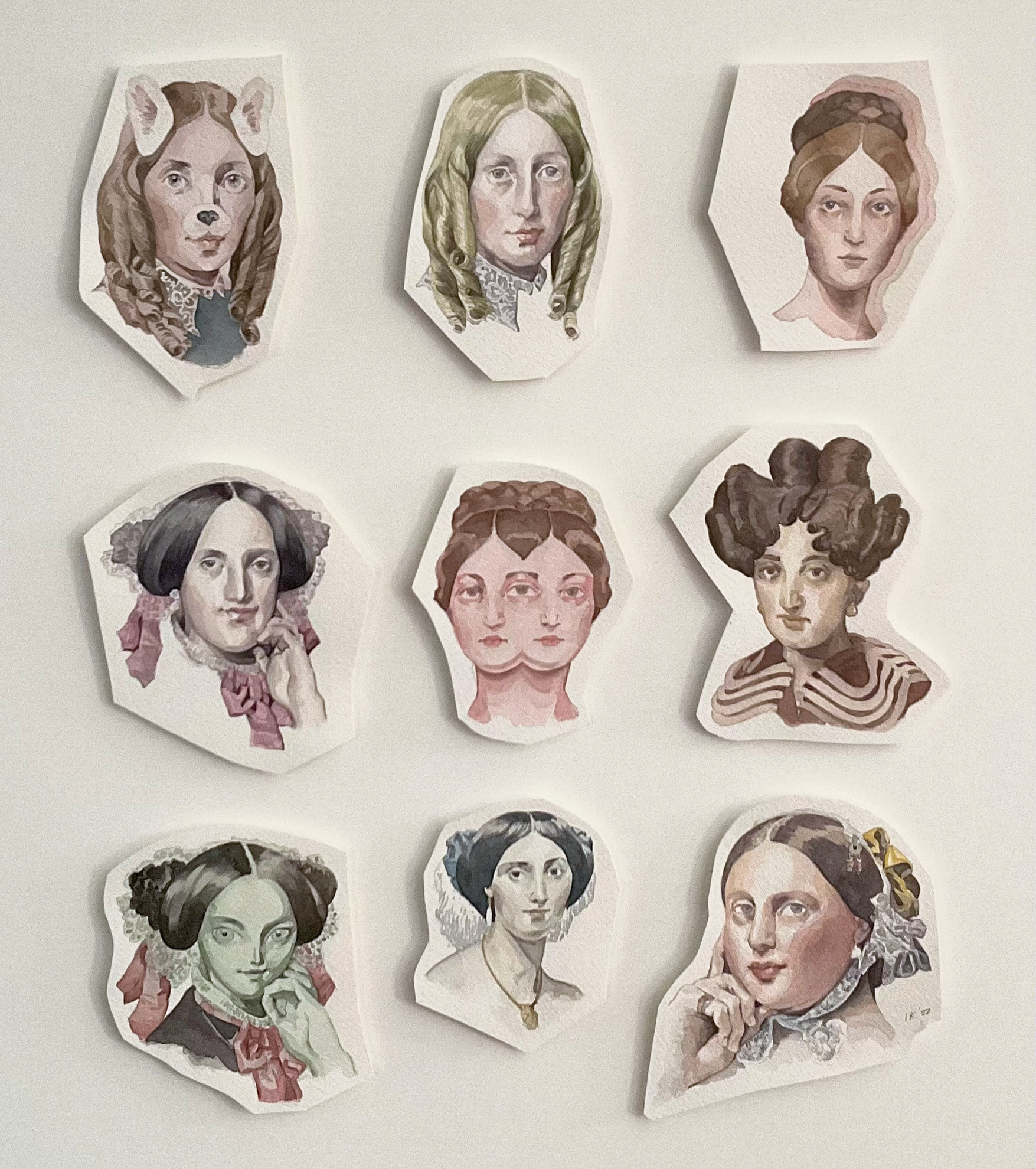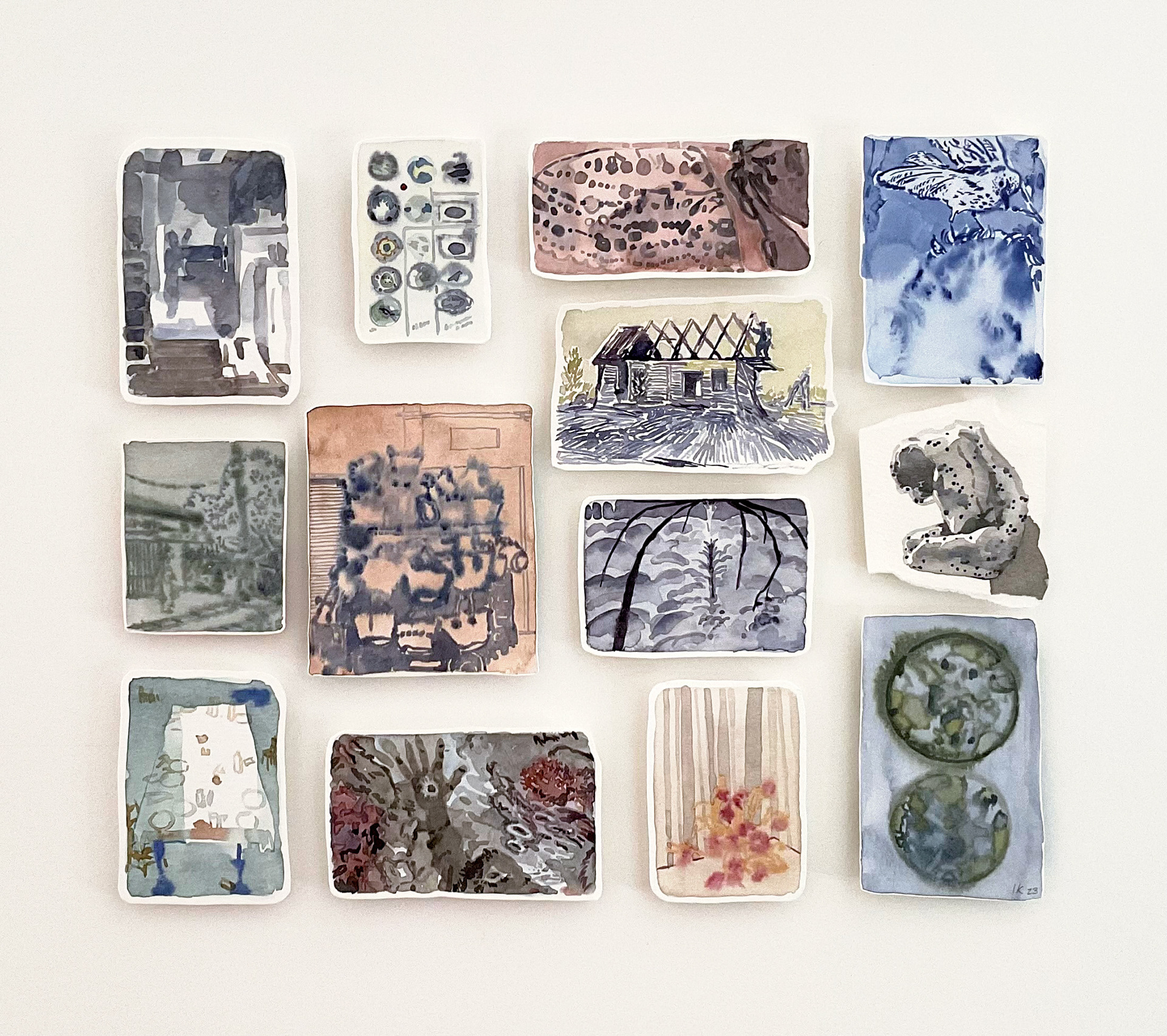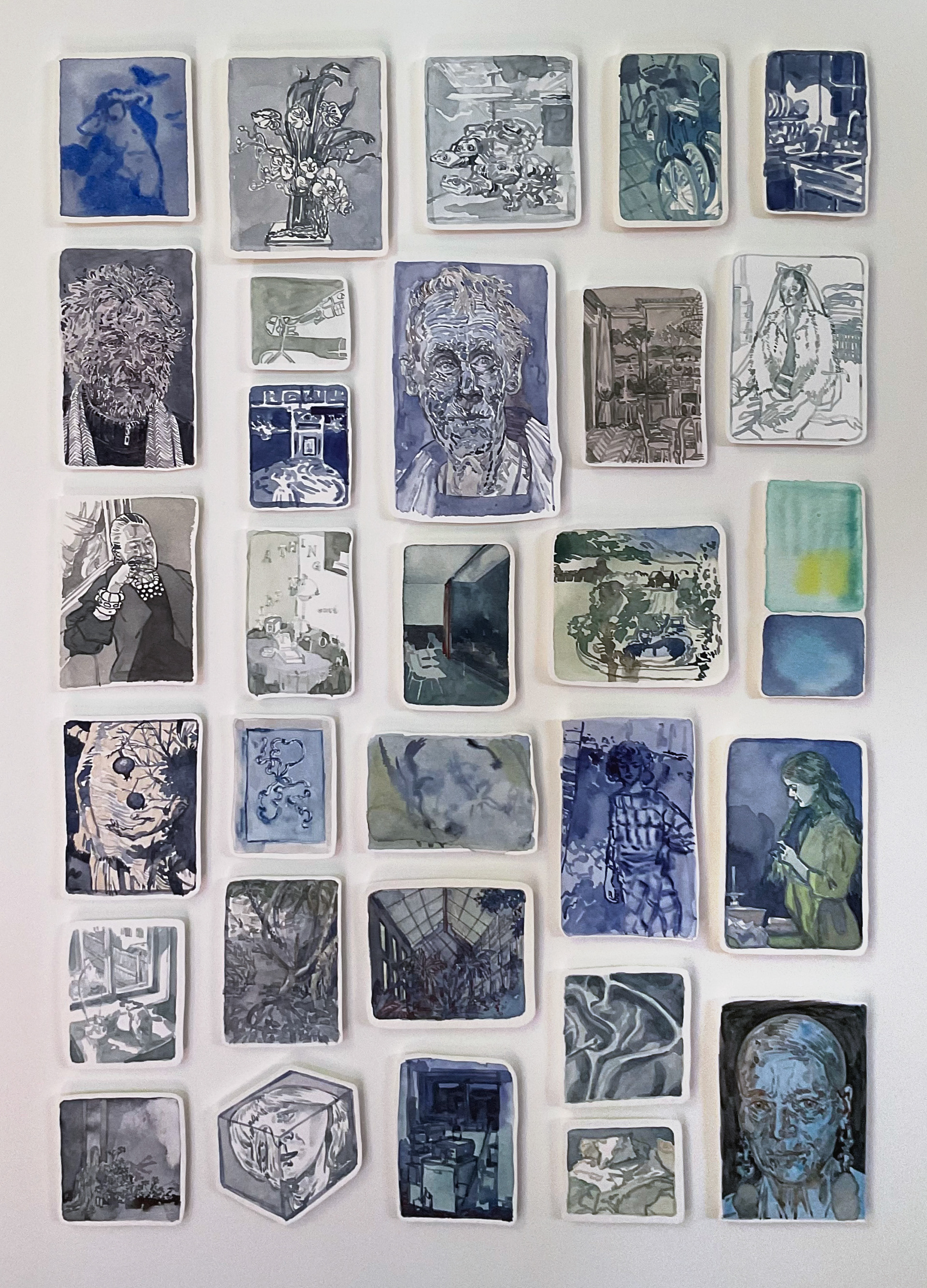STUDIES
A solo exhibition at the Ilse Schermers Gallery in Stellenbosch, South Africa in March 2023
Materially, my painting practice involves finding ways to work experimentally and playfully with watercolour, a medium that has quite old-fashioned associations. Studio space constraints as well as moving back and forth between London and Greyton, have lead me to create these small studies which I have been compiling into larger compositions based on their similarities.
My sources for these studies are Pinterest, art historical images, my own photo library and news sites. By trawling through these different sources I am investigating the enmeshment of personal and public content and the narratives and parasocial relationships that arise from this. My practice is concerned with the flow of information and intimacy through mediums such as social media sites.
I was so grateful that Prof Elisabeth Gunter, who was a lecturer of mine in 2010, gave an opening address.

Christening, Isabella Kuijers, 2023, 60cm x 60cm

Long After Ingres, Isabella Kuijers, 2022, 68cm x 59cm

Tiles (with barn), Isabella Kuijers, 2023, 50cm x 56cm

Tiles (with oxalis), Isabella Kuijers, 2023, 55cm x 51cm

Blue World, Isabella Kuijers, 2023, 85cm x 65cm

Bored of Directors, Isabella Kuijers, 2023, 80cm x 66cm

Catwalk 1, Isabella Kuijers, 2023, 65cm x 51cm

Tiles (with trophies), Isabella Kuijers, 2023, 48cm x 55cm

Naartjie, Iggy, Pink Skin, Catwalk 2 & Made the News, Isabella Kuijers, 2023, 35cm x 105cm
OPENING ADDRESS
BY PROFESSOR ELISABETH GUNTER
I raided Isabella Kuijers’s Instagram pages to learn more about her work, and indeed also more about Isabella. In those weird and eerie spheres of social media, she allowed me glimpses into her thinking and doing that I now read here in her work too. Here, as in social media, she generously grants us precious fragments of her observations and thoughts. She has long since shed any reticence about using the internet as source, acknowledging a virtual world as complicit in shaping how she sees things and how she practices her art. In her creative process Isabella brings together traditional and contemporary technologies and media with a very sharp intellect that discerns with swift skill and playful wit.
Isabella shows us that we can hardly afford to, for a moment longer, deny or shun the power of the Internet and Social Media to shape our thinking and doing. The quality of the work on display here pays testimony to such realization, one rather startling to someone of my generation.
Perception
The flows of internalisation and externalisation that we nowadays can conduct in and between not only self, ‘reality’, or life-world, but also in the virtual realms of a seemingly vacuous reality, fascinates Isabella. She gives figure to form that was mediated by social media, offering little morsels of fragmented visuality that have shaped themselves as her particular take on whatever, whoever she encounters both in there (online), and out here.
Language and a Micro-dialect
She offers us glimpses into the lives of others, past or present, repositioning all in her space, in her own time, and here, mainly in watercolour as medium. Her choices and inscriptions relate the intimacies of an aesthetic idiolect, a kind of micro-dialect, that astonishes and mesmerises with its density and variety. In this way, however furtive the spectre of her presence might be, we perceive the entire installation as a self-portrait. Her choice of subject matter is unique, marking a personal history not par for the course to all others. She follows only her own head in filtering (and embellishing) visual information, the mark of her hand always true only to itself. In her own words, Isabella proposes that “in the act of attempting to communicate, we encode parts of ourselves and our tools into the message”. The mark she understands and asserts as language, drawing lines that to her are “like written lines”. In Isabella’s hands this becomes a rich and eloquent language, one that grows its grapheme on internal levels so densely replete that it reveals what was either meant to remain hidden, or not, for that matter. To inscribe (to make and mark) rather than to utter becomes both weapon and shield, compass and shelter, forcing those back and forth shifts between not-knowing, unknowing, and knowing that bring understanding. I quote here her own words: “I’m interested in the accumulation that happens internally”.
Isabella Kuijers and Prof Elisabeth Gunter, doing the opening address.
Isabella logs, documents, and records only to re-arrange, re-imagine, and re-image.
Her curiosity about beings, objects, spaces both physical and non-physical, ordinary or extra ordinary, is insatiable, and she chronicles all with acumen and skill. She shows with beautiful confidence and strength that her particular fascinations and interests also outline identity, revealing in her art a self-as-undeniably-present, deeply engaged in this life.
Isabella understands and harnesses the fluidities of time and place.
Instagram reveals that she hardly ever stays in one place. Her travels, in both virtual and spatial realities, take her everywhere, breaking the confines of time and space. “How strange,” she says, “to be intermittently stuck in one place or another”. Elsewhere, she says with eerie accuracy: “Time is weird”.
Her myriad acts of drawing, painting, composing, creating new connections, and re-contextualising all the snippets that we see here are irrevocably fused in and intimately influenced by the times during which they were created – originally, in re-interpretations, or in technologically reproduced forms. In her iterations, they become yet more layered, now imbued with Isabella’s in-phase enactions, capturing those in-process, unpredictable happenings that irrupt only in and through mark making. The flows of information that she in this way conducts between life-world, virtual reality, and giving figure to her understandings there-of develop with recursive force, always fluid, never done, without end. Again, I quote Isabella: “Drawing an itinerary of the things I can see this afternoon. Thereby taking it with me into the future”.
The Portal
We can read in her work movement from and towards, transition that finds its way through what she calls “a portal”, and that I now (perhaps wrongly) construe to be, in this case, the act of drawing. The portal channels quite complex passages, encompassing those of time and space, and those of the mind and intellect, of affect, but also those of creativity: giving figure to a new way of seeing and knowing.
This brings me back to Isabella’s particular micro-dialect, or aesthetic idiolect, her particular visual language, as a peculiar sensitivity towards how we all layer our exchanges in ranges of different tones and timbres (“different registers”). She collects objects, people, spaces, scapes, with rare intensity. She quite playfully brings them together almost as visual poems, even showing us the gateways she has found to be significant markers of her being in this life. She places, replaces (or perhaps displaces) them in contexts and spaces quite unknown to them, forcing new and wonderfully uncanny connections between all and sunder.
Isabella summarises the above as follows: The shape of writing and language seems to be a theme in almost all my work, along with ideas of distortion and translation...
...but it is very expressive and confusing... Like a lot of communication...
Studies, Isabella Kuijers, 2023, 120cm x 140cm